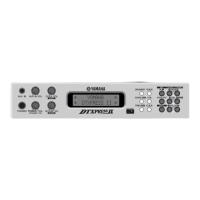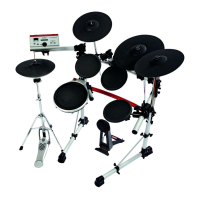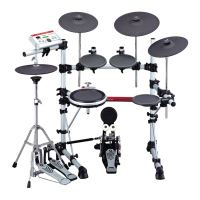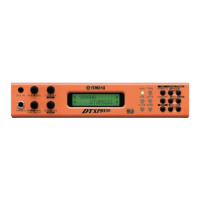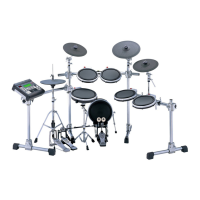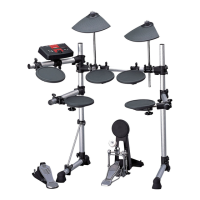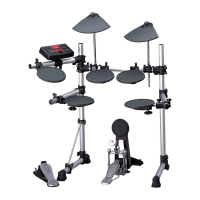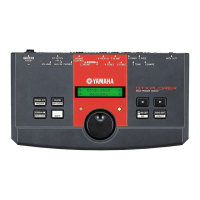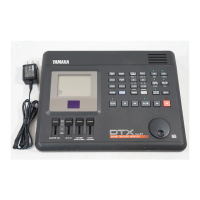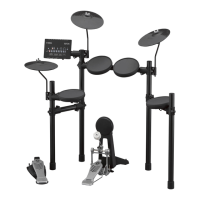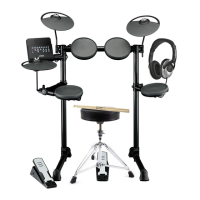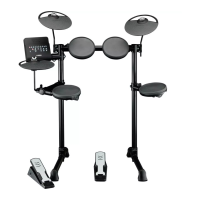11
This mode contains various settings related to trigger
input from the pads and trigger sensors that are con-
nected to the DTXPRESS III.
It allows you to adjust pad sensitivity and assign drum
voices to each trigger input. Trigger Setup data consists
of seven preset types (No. 1-7) and four original setup
types (No. 8-11) for storing user setup data.
■ What you can do with the Trigger Setup Edit
Mode
The Trigger Setup Edit Mode lets you alter a variety of settings for
each of the trigger inputs jacks (1-10) of the Trigger Setup.
You can edit both preset (No. 1-7) and user Trigger Setups (No. 8-11).
The edited Trigger Setup can be stored in a User Trigger Setup
(No. 8-11) using the Store Operation.
* Selecting another Trigger Setup before storing your changes
will result in the data reverting to its default settings.
* Data cannot be stored to preset Trigger Setup (No. 1- 7).
■ Entering the Trigger Setup Edit Mode
Hold the [SHIFT] button and press the [TRIG] button on the front
panel.
Once the Trigger Setup Edit Mode is entered, the INPUT
parameter’s main page (pad type), shown below, will be displayed.
5.
Use the [VALUE–], [VALUE+] buttons to set the
parameter’s value or ON/OFF setting.
* Once a setting is changed, “*” will appear on the display next
to “TRIG”. After data is saved, the mark will disappear.
Trigger Setup Edit Mode
■ What’s in the Trigger Setup Edit Mode
The Trigger Setup Edit Mode is divided into two sub-groups.
1. INPUT Parameters ............................... mP. 12
Contains specific settings for each pad (1-10).
2. COMMON Parameters ......................... mP. 14
Contains common settings for all pad inputs.
Procedure
1.
Press the [TRIG] button to enter the Trigger Setup dis-
play, then select the trigger setup you want to edit.
2.
Hold the [SHIFT] button and press the [TRIG] button to
enter the Trigger Setup Edit mode.
3.
Use the [PAGE▲], [PAGE▼] buttons to display the list
you want to edit.
* If the Utility mode’s [2-4. Jump to Recent Page] parameter (P.
30) is set to “on”, the DTXPRESS III will display the page last
edited when entering the Trigger Setup Edit mode.
4.
Use the [SEL<], [SEL>] buttons to move the cursor to
the list you want to edit. The list will flash.
* If there is only one list, it is not necessary to move the cursor.
TRIG IN= 1
Type= KP
6.
To store changes in the User Trigger Setup, use the fol-
lowing procedure.
* The changes you made will be lost if another trigger setup is
selected before your changes have been stored.
6-1. Press the [SAVE/ENT] button. The following display will
appear.
6-2. Use the [VALUE–], [VALUE+] buttons to assign the User
Trigger Setup number (6-9) (located next to “To=”) for
storing your changes. The number and setup name will
appear.
6-3. Press the [SAVE/ENT] button, the following display will
appear asking for confirmation before the store opera-
tion is carried out.
6-4. Press the [SAVE/ENT] or [VALUE+] button, the store
operation will be carried out.
*
Press the [VALUE–] button to cancel the store operation.
The following display will appear after the store opera-
tion is completed.
Trigger Setup Edit Mode Function List
Page
1. INPUT Parameters .................................................. 12
1-1. Pad Type.......................................................... 12
1-2. Gain, Minimum Velocity ................................... 12
1-3. Velocity Curve ................................................. 13
1-4. Self Rejection, Rejection ................................. 13
1-5. Specific Rejection ............................................ 13
1-6. Trigger Setup Copy.......................................... 14
2. COMMON Parameters ............................................ 14
2-1. Hi-Hat Offset.................................................... 14
2-2. Increment/Decrement ...................................... 14
2-3. Input Exchange ............................................... 15
2-4. Trigger Setup Name ........................................ 15
TRIG*IN= 1
Type= KP
Store Trigger
To= 8 InitTrig
Store TRG to 8
Are you sure ?
Complete !
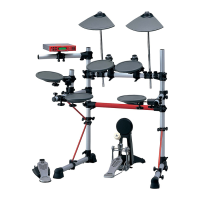
